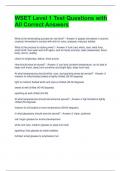Exam (elaborations)
WSET Level 1 Test Questions with All Correct Answers
- Course
- Institution
WSET Level 1 Test Questions with All Correct Answers What is the winemaking process for red wine? - Answer grapes harvested in autumn, crushed, fermented in contact with skin for color, pressed, matured, bottled What is the process for tasting wine? - Answer look (red, white, rose, what hu...
[Show more]



